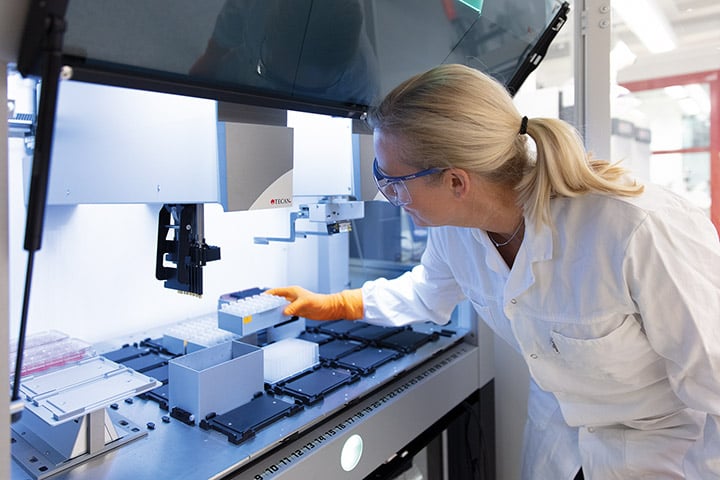Determining if a new cosmetic product, pharmaceutical ingredient or chemical substance is harmful to humans is a key prerequisite for product safety and consumer protection. Traditionally, skin sensitization testing relied on animal models, but these approaches are expensive, time consuming and raise ethical questions, while only offering limited human relevance and accuracy. SenzaGen has developed a unique, in vitro approach to sensitization testing, combining cell biology and flow cytometry with genomics-based screening and machine learning-assisted classifications.
The use of animal models for safety testing of pharmaceuticals is coming under increasing scrutiny due to a combination of financial and ethical pressures, and a growing scientific awareness that the results of these studies can be inaccurate or misleading. Although animal testing is still mandatory for the regulatory approval of pharmaceutical products, many other sectors are moving away from the use of animal studies in determining product safety. Probably the most prominent of these is the cosmetics industry, where animal testing has already been banned in many jurisdictions worldwide for a number of years. The EU ban on the use of animals to test the safety of cosmetics or their ingredients came into force in 2013, and created a need for alternative strategies for skin sensitization testing. This led to the spin out of Swedish start-up SenzaGen from Lund University’s Department of Immunotechnology, as company CEO Axel Sjöblad explained: “SenzaGen was created to provide an advanced in vitro approach to sensitization testing that combines cell biology, genomics and machine learning to classify substances as either sensitizing or non-sensitizing. The ban on animal testing in the cosmetics industry was the driving force behind the company’s founding – and this remains a key market for us – but we have since expanded into a number of other areas.”

The Fluent workstation provides Ulrika Mattson (pictured) and the SenzaGen team with consistency and reliability for the GARD assays
“There is growing demand for this type of service across many other sectors – including the chemicals, pharmaceutical and medical device industries – as researchers and regulators are becoming increasingly aware of the scientific shortcomings of animal testing, and companies working in these areas try to reduce the cost of safety testing. Our flexible technology platform has allowed us to develop a range of scalable assays to meet the needs of these different markets and, today, we offer four distinct tests – GARDskin, GARDpotency, GARDair and GARDskin Medical Device.”
Ulrika Mattson, Senior Application Scientist at SenzaGen, took up the story: “Our GARD assays can essentially be divided into six steps; the first two are cell based, and the remaining steps involve genomics and machine learning. The process begins with our own human myeloid leukemia cell line, SenzaCells, which we expose to varying concentrations of the test compounds that we receive from our customers. Following overnight incubation, we then perform a cell cytotoxicity analysis using flow cytometry, and isolate RNA from the cells for transcriptomic analysis by hybridization, based on a custom gene panel unique to each assay. Finally, we use our in-house machine learning algorithms to analyze all the data and determine which compounds are sensitizing.”
Crucially, we immediately had a good connection with the local Tecan representative, who worked hard to understand our exact requirements and what we wanted to achieve through automation.
Ulrika continued: “The accuracy of the first steps – creating serial dilutions of each of the test substances, dosing the SenzaCells, and cell harvest for both cell cytotoxicity analysis and RNA isolation – is crucial to the outcome of the process. We were initially performing these steps manually, but quickly realized that automation of this portion of the workflow, which is time consuming and requires very precise and accurate pipetting, would be really beneficial. This was primarily because of the release of resources and consistency automation offers, rather than to increase throughput, although automation obviously gives us the capacity to cope with significant expansion in the future. We looked at the various solutions on the market that could meet our requirements, and eventually chose the Fluent® Automation Workstation, because it offers very precise, fast and accurate pipetting, and could be configured to be very flexible to accommodate our development needs, which is an important consideration for a company in the commercialization and growth phase. The system also has a number of integrated options – such as a tilting carrier to reduce dead volumes, and a HEPA filter hood to prevent contamination – that were important for our workflow. Crucially, we immediately had a good connection with the local Tecan representative, who worked hard to understand our exact requirements and what we wanted to achieve through automation before we even purchased the system.”

Axel Sjöblad, CEO of SenzaGen
“Although we had not previously worked with Tecan, I have over 20 years of experience in laboratory automation and, for me, it is very important to factor in the support you will receive when choosing a solution for your lab. For example, when we first established our automated protocols, we were experiencing poor cell viability compared to manual processing, but the support we received from Tecan’s field application specialists helped us to resolve this issue by using gentle pipetting parameters in combination with the company’s wide bore tips. This kind of advice is vital to getting the most out of any automated solution, as even seemingly straightforward pipetting operations pose technical challenges when you require absolute consistency and reproducibility.” Axel added: “The Fluent platform fits very well into our workflow, consistently and reliably performing the routine operations that are crucial for our process. This has helped us to create a technology platform that outperforms all the in vivo and in vitro tests currently on the market, and provides a real and practical alternative to replace the one million mice a year currently used for skin sensitization testing.”
To find out more about Tecan’s cell-based screening solutions, visit www.tecan.com/cellbiology
To learn more about SenzaGen, go to https://senzagen.com
Keywords:









